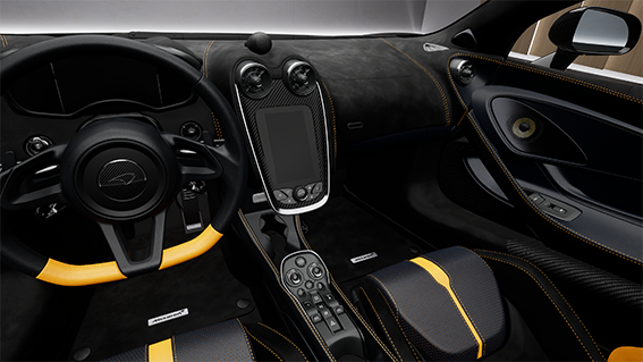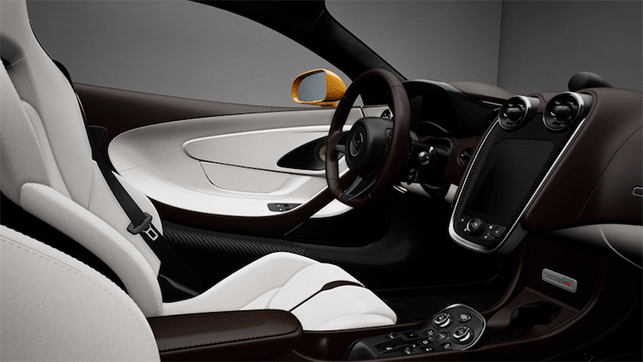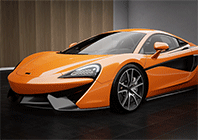
A McLaren 570GT, rendered in Unreal Engine, which enables it to be moved in realtime VR, and exhibit true to life lighting and real world physics effects
McLaren’s existence is based around its search for perfection, from an incredible automotive division to its F1 team, to the operating theatre clean spaces that make up its purpose-built headquarters.
The gleaming, sweeping parade that connects all its divisions under the same roof is stocked to the brim with jaw dropping vehicles that curve around the floor. There’s not so much as a branded pen out of place.
One of the McLaren mantras is We do everything for a reason, which it doesn’t take long for Mark Roberts, design operations manager at McLaren Automotive, to demonstrate to us with the help of a gleaming 570GT.
With the car rotating on a turntable a few feet away from where we’re sat in one of the showrooms, Roberts skips over to show us where air attaches to the car body and wraps around its lines – even down to the wing mirror arms.
“They’re not just holding up the mirror on our cars, they’re an aerodynamic blade directing airflow; so, it’s absolutely critical that all these things link together in the design of the car,” he explains with a glide of his hand.
The 570GT is one of the marques most desirable grand tourers, meant for long hours’ pleasure on winding European roads, with realistic luggage space and an airy, luxurious feel to the cabin. A daily drive, should your purse strings stretch that far, but that’s not to say that it lacks any of the spark that comes as standard with McLaren’s race heritage.

Interior design reviews benefit from having the ‘driver’ in situ, with the ability to quickly change between themes
Kicking off the design process
The design process of getting from a blank sheet of paper to this final car takes from 12 to 18 months – blisteringly fast – and a timescale McLaren only ever looks to improve on.
“Any tools to help us speed up and optimise that process, we’re absolutely, fully embracing,” admits Roberts as we run through the design process at pace.
The early process is back to basics; a clean sheet of paper, pens, pencils and markers, where the team start 2D sketching.
The design brief consists of engineering hard points – where the engine, gearbox, radiators and other components will need to sit; all of the things in vision lines, and legal guidelines – combined with a marketing brief, taking in competitor cars in that sector, the price and the main use of the car. A vehicle like the 570GT is more practical, so that dictates luggage space and a wide fi eld of view, while the P1 is a race minded ‘fighter-pilot’ experience.
Roberts explains that to start with it’s very competitive amongst the team: “There’ll be four or five designers that will be doing all of these little ‘thumbnail’ sketches, lots and lots of different ones, thinking ‘don’t like that, don’t like that, ooh! I like that one!’
Every couple of weeks a review with the management exec team, complete with presentations and full size sketches, will funnel down the concepts that work.
Moving on over the next few weeks, these multiple sketches are worked down to four themes, where initial 3D volume models can be created in CAD with Autodesk Alias.
Within a week of the move into 3D the team have very early volume models that can be rotated on screen, letting the designers see that where the sketch may have looked beautiful across the rear three-quarters, when it goes into 3D then it might not work.
Roberts explains that not everything is lost: “We might need to do a bit of massaging and a bit of fiddling, and you might find that ‘the rear deck’s not going to work because you need ‘more airflow coming off it…’ and again, they can do a bit more work on it.”

The pipeline between McLaren’s CAD data and Unreal Engine’s games engine VR is critical to creating believable experiences
Step in Virtual Reality
Typically, McLaren transfers the Alias designs direct to Autodesk VRED and uses a Power Wall for reviews, with cars visualised at full size with basic grey shaders to give an impression of the light and shade falling over it.
However, like everything at McLaren, this is fast changing, evolving instead to use the immersive benefits of Virtual Reality (VR).
The move has already proved an immediate step forward; although you can’t touch or feel it, the designers and management team can get a much more tangible sensation of what the car is like.
“You can walk up to it, squat down and look along the light lines, and it’s nothing like sophisticated enough at that stage it’s just a basic volume model, so it’s not got any subtleties about it, but it’s enough that you can start to judge if that volume is working.”
Although the process was previously manageable, getting it to such a believable level, without lag in the VR headsets, was prohibitive to the process.
Roberts has instead directed the team towards the smoother visual benefits of games engine technology and Unreal Engine.
“I can’t stress enough the importance of the pipeline. If you’ve got heavy data, then it just kills the technology; you’ve got to have a super lightweight tech.”

McLaren’s high tech headquarters in Woking
Forget about the technology
For McLaren, the most important thing was for the viewer to be able to forget about the technology completely.
“The way you can just move around really naturally, and that’s another word I use a lot; it’s just got to feel like a natural experience.
“If we need people to be looking at the quality of the shut-gap, or the design, or any specific features – the curves – that’s what we want them to critique, we don’t want them thinking this is jittering or uncomfortable,” explains Roberts.
“The whole thing is about believability and confidence in what you’re seeing, and then you make design decisions.”
In parallel to the virtual model, a 1:1 scale ‘speedfoam’ lightweight polystyrene model is CNC machined, next to which the team can park physical benchmark cars – competitor cars and their own existing models – for comparison.
The four themes then work down to two, and then a single theme over the course of a few months, reaching the stage where a full-size clay model is then machined, sculpted, and finessed for the exterior and cabin, while the data is all the time being tweaked, scanned and the geometry reapplied to the CAD model.
“The pressure is on us to always be doing it faster, more efficiently and improving the quality of design in our products, but to do it faster so we can jump onto the next one,” says Roberts.
“VR can give the confidence to move forward with something, or it can actually tell them straight away that this is going nowhere and just to forget it.”

The Boulevard, a parade of amazing vehicles from McLaren’s history

The incredible detail captured in the renderings is also ready to be explored in smooth realtime VR
From the interior to the exterior
In parallel with the design of the exterior, there’s also the interior of the car to think about, to which VR offers just as much or maybe even more value.
Previously a car interior volume was replicated by lightweight foam volumes, coming together quickly from lots of 2D sketches that evolve much faster than exterior styles, typically running with two good themes.
A basic seating buck was fitted with a full milled foam dashboard, steering wheel, centre console, doors, door cards (the inners) and often a roof structure sitting over the top of it.
A very basic physical solution, it fitted the needs of designers looking to get a feel of what it is like behind the steering wheel. Then, the driver steps out and with a change of panels, version two can be assessed.
“Where that’s really changing for us now is that we’ll set it up with a headset and you can flick through [versions] – all you need is a tub and a seat, and everything else is virtual.”
Using a carbon fibre monocoque buck with one seat in it, the interiors team set up a HTV Vive around it, displaying the realistic rendered images of the 3D model.
This offers all the same abilities and sense of space as the physical mock-up, but with added benefi ts, such as for checking rear visibility and the ergonomics of reaching buttons, while the instant toggling back and forward between the two themes allows better decision making.
“You can prove that out so easily and quickly in VR,” says Roberts, adding that the ability to do on the fly changes to CAD and have it appear on the headsets in real time is not far away. “It’s a massive step forward from the previous way of doing it.
“A designer is most discerning – if they look at a material or anything, and if for any reason the stitching is wrong, or something looks odd with it, then your brain automatically tells you it’s not real, and then you start looking at everything else and you start to question the whole thing.”
“This is a process in evolution,” explains Doug Wolff, partner technology manager at Unreal Engine Enterprise, which has invested a great deal of its expertise towards developing McLaren’s VR pipeline.
“Over the course of this year, we are working to build a completely automated pipeline from engineering data, right into visualisation. We have demonstrated that this is possible through a couple proof of concepts, and we are doing more now.
“It is all about using the CAD data that is ‘business as usual’ for McLaren that is produced to build vehicles and making that automatically suitable for beautiful, ultra-fast preview in VR.”
Aiding enterprise customers is something games engine technology leaders like Unreal Engine are keen to be a part of. “We help find partners, bits of technology and plugins to create an ecosystem for McLaren. If something is missing, we have the capability to hop right in there and build it,” explains Wolff .
“While the goal of design review might be the same at many automotive OEMs, the specifi cs usually require some custom-fi tting, and the Unreal Engine team is there to assist making sure that ‘custom fit’ is the best it can be.”
McLaren’s proofs of concepts for VR have usually needed around a day to process all the data for the first time, but after that, day-to-day updates can occur in just seconds.
From the customer’s side, this pipeline is the key factor, as Roberts explains: “What I always bang on about, which is the absolute key to it, is to get our designers to embrace the technology: They’ve already got a tried and tested process, they’re happy with that to a large extent. To get them to switch to VR means that it has to be so seamless.”

3D models mean that what began as 2D ideas can truly be tested and viewed from all angles
Adoption across the family
The confidence in VR is reflected in its adoption across the entire McLaren Automotive family.
Quality assessment (QA) audits now begin in VR before a physical car is available. “It’s a really early gateway, when we don’t have any physical models other than a rough old engineering mule that is not a pretty car.
“At the same time that’s running around on a secure test track, they can be checking the QA audit, the shut gaps and the quality of panel gaps, and they can stack up the worst possible scenarios and highlight to everyone immediately that ‘you need to look at this’,” says Roberts.
The manufacturing team can look at a VR car and start to understand how they’re going to be able to fit parts, or what considerations need to be thought of far before they even set eyes on any physical parts.
With 90 dealerships globally that look after the servicing of local cars, currently the senior people from those dealerships will fly in to Woking for training workshops.
In the very near future they can be trained with VR, adding more value to existing CAD data.
Sales rooms are set to benefit greatly from the power of VR; where a dealer might only have one or two cars in stock to show customers, an upgraded version of the design review seating buck with VR can prove a huge sales tool.
“Rather than having some coloured swatches [on a table in front of them], they can sit in the car virtually and do it.
“The bit I loved that showed how successful it was, was they’ve got the headset on, they’re in a virtual car, and the first thing they do is reach out for a steering wheel that’s not there! They just forget themselves and believe it, which is exactly what we want,” adds Roberts.
The ability for McLaren’s design team to be using that same lightweight games engine technology to get closer to the details, to fine tune every surface and angle – and believe it too – means that once again everything the company does is for a reason.

cars.mclaren.com
unrealengine.com
This article is part of a DEVELOP3D Special Report into Virtual Reality (VR) for design, engineering and manufacturing, which takes an in-depth look at the latest developments in software and hardware and what you need to get up and running.
VR for design & engineering A look at the benefits that greater interactivity in a virtual environment can bring to design and engineering
Quick guide: VR enabled applications A list of what’s out there now or coming soon
Virtual Reality challenges & future Six industry thought leader’s views on the future of VR
HTC Vive: Getting up and running Our experience of working with HTC Vive and how to avoid common mistakes
Workstations & GPUs for VR A back to basics guide to buying hardware for Virtual Reality
The future of immersive engineering Virtual Reality (VR) is the current hot topic, but Augmented Reality (AR) and Mixed Reality (MR) is on its way. We take a look at where things are heading
Game on Amalgam creates game controllers for Holovis
VRED Pro 2017 & VR The latest release adds greater support for the HTC Vive and Oculus Rift tools
Virtalis VR4CAD Offering expertise in VR at a much more affordable level
ESI Group IC.IDO 11 ESI’s IC.ID0 is one of the most advanced Digital Mock Up tools available. With its addition of Vive support, we take a look at what the system is capable of and how it can benefit engineering
Gravity Sketch Beta An interesting take on Modelling in Virtual Reality
Google Tiltbrush A system for VR creativity that’s both cheap and capable
Oculus Medium A good contender for design experimentation
Amari Magnetar V25 This stylish workstation has been specifically designed for VR. But despite its slimsline chassis, you can still cram in incredible processing power
Nvidia Quadro P2000/P4000 Nvidia is changing the landscape of professional 3D graphics with a new family of Pascal Quadro GPUs, including a single slot ‘VR Ready’ card.

To read all the articles, as they appeared in DEVELOP3D Magazine, you can download the March Edition here.

How McLaren Automotive unleashes VR to create faster cars with more attention to detail
Default






